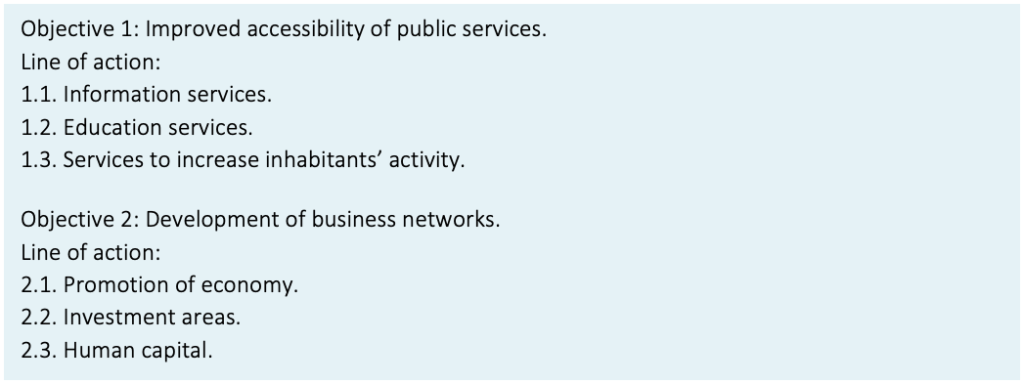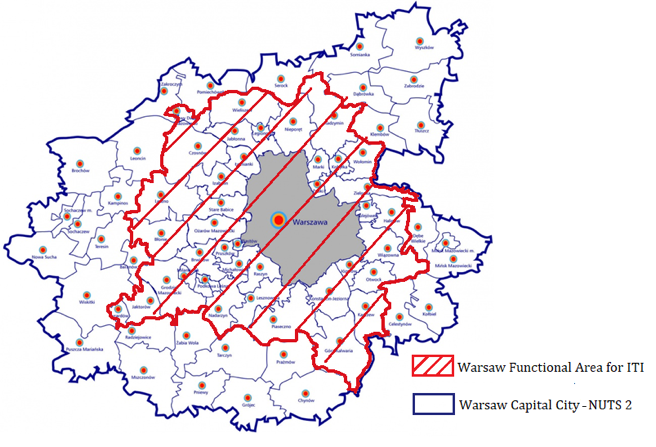Andżelika Mirska, University of Warsaw
Relevance of the Practice
Warsaw is the largest city in Poland, its capital city, and is centrally located. Until 2002, the city area was divided into 11 independent gminas which formed the obligatory municipal union of Warsaw. Since 2002, these gminas have been transformed into 18 districts (auxiliary units) and Warsaw has become a uniform gmina with 1.7 million inhabitants. A functional area of Warsaw was naturally created, which, depending on the concept, includes from 39 to 72 gminas. However, despite the pressing needs of local governments’ cooperation, for a long time Warsaw’s cooperation with neighboring local governments has not improved at all (despite various projects and declarations of cooperation). The launch of Integrated Territorial Investment (ITI) from the EU was decisive and forced such cooperation in Poland.
The previous lack of voluntary cooperation among communes was caused by several reasons. Financial issues (no additional financial incentives) as well as mutual prejudices and the concern about dominating small communes by Warsaw played a significant role. Moreover, there was no cooperation habit. Mayors of communes around Warsaw assess Warsaw as a partner acting from the strength position, uncomprehending the small communes’ problems and generally not interested in voluntary cooperation with them.
The lack of cooperation between municipalities around Warsaw is claimed to be also due to selfishness and caring only for their own interests. ‘There are many local governments that only invest in themselves as a part of the competitiveness. They want to demonstrate their communes as the leaders. They do not want to cooperate with other communes so that a neighboring commune accidentally would either not benefit from this cooperation or not take over the competitiveness on its own side. This is the jaundice.’ – Opinion of one of the mayors of the communes near Warsaw. Therefore, mutual self-perception as competitors is the problem. The lack of trust and the lack of social capital are also factors that influence the relations between local governments. The opinion among mayors concerning local governments in the area around Warsaw that are diverse and have little common interest is another characteristic feature. The division into east and west, into rural and other communes, into communes located very close to Warsaw and those located further away, and into economic specializations: logistics, judiciary, tourism and others are identified.[1] According to P Swianiewicz, the similarity of partners contributes to the cooperation. However, large differences usually cause friction between small suburban communes and a much larger central city. Thus, local governments compete against each other for residents, tourists, investors and public funds. Consequently, the problem of establishing common interest in terms of the cooperation undertaken is a fundamental issue.
The new instrument of the European Union, i.e. Integrated Territorial Investment (ITI), is a response to the development needs of metropolitan areas, including metropolitan Warsaw in view of the above barriers to voluntary cooperation of local governments (bottom-up) and the lack of legal regulations which regulates the commune governments cooperation within urban agglomerations (top down).
The significant role of external financing for building cooperation relations between local governments is indicated.
Description of the Practice
The ‘Warsaw Functional Area for ITI’ was established in 2014. It encompasses Warsaw and 39 gminas surrounding Warsaw, 2.7 million inhabitants, area of 2,932 sq km. The partners had to enter into the ‘Agreement of the Gminas of Warsaw Functional Area on cooperation in the implementation of the ITI in the EU 2014-2020 financial perspective’[2] and agree on a joint ‘Strategy’ document.[3]
This strategy focuses on three objectives to be achieved through specific lines of action:


The organizational structure of the ‘Warsaw Functional Area for the implementation of ITI’ includes: (i) Steering Committee, (ii) Consultative Forum, (iii) Secretarial Office
The ‘Warsaw Functional Area for ITI’ consists of one city with county rights (the Capital City of Warsaw), 14 urban communes, 12 urban-rural communes and 13 rural communes. Administratively, these communes belong to 10 counties. It concentrates over half of the voivodeship’s residents (50.5 per cent) despite the fact that this area covers a relatively small part of the Mazowieckie voivodship (8.3 per cent). Due to the specificity of the area, especially the number and size of settlement centers, the urbanization rate for the ‘Warsaw Functional Area for ITI’ (87.5 per cent) is significantly higher than the value for the Mazowieckie Voivodeship (64.2 per cent), as well as the entire territory of Poland (60, 6 per cent). Moreover, the ‘Warsaw Functional Area for ITI’ is the most densely populated area of the voivodeship (912 people / km2). This value is over six times higher than in the entire Mazowieckie Voivodeship case (149 people / km2).
Contracts were signed for 115 projects for the grant amount of PLN 606.5 million. What is more, they will be implemented individually by communes in partnership with communes around Warsaw, in partnership with Warsaw, as well as by non-governmental organizations operating in the metropolitan area and private entrepreneurs. Everything is connected with the partnership resulting from the 40 communes’ agreement signed in February 2014 and the joint ITI investment strategy. The projects concern both the problems of rural areas (e.g. educational programs for rural schools in the commune to provide equal educational opportunities for children) and the metropolitan problems (the provision of childcare facilities for children in nurseries in one of the districts of Warsaw with the highest birth rate[4]). There are also projects implemented jointly by several municipalities, such as the construction of bicycle paths connecting 6 communes. Projects with impact on all local governments i.e. in the field of e-services are also distinguished. For instance, the project entitled ‘Construction and implementation of an integrated support system for care services in the Warsaw Functional Area (E-Care)’.[5]
Assessment of the Practice
The cooperation of local governments in the functional area of Warsaw is an urgent necessity. The ITI was a catalyst for such cooperation. As it has not been in place for long, it is still difficult to assess the effects. The actions and mechanisms of cooperation should be examined. However, the initiation of such cooperation is certainly a success. Preparations for the next period of EU funding for ITIs (2021-2027) are currently ongoing.

Apart from the establishment of the ITI program, the second factor that influenced the discussion on the Warsaw metropolitan area was the division of the Mazowieckie Voivodeship into 2 statistical units at NUTS2 level (from 1 January 2018). ‘Warsaw Capital City’ NUTS was identified, which included Warsaw and 70 surrounding gminas. A milestone for further joint metropolitan activities will be the ‘Strategic Action Plan for the Warsaw Metropolis – Strategic Guide 2.0’ developed by local governments, indicating the development needs of the metropolis in the coming years.[7]
References to Scientific and Non‐Scientific Publications
Bieńkowska M and others, ‘Region of the Capital City of Warsaw in 2017’ (Statistical Office in Warszawa 2018) <https://warszawa.stat.gov.pl/en/publications/others/region-of-the-capital-city-of-warsaw-in-2017,24,1.html#>
Bourdeau-Lepage L and Huriot J-M, ‘Metropolization in Warsaw. Economic Change and Urban Growth’ (2002) 25 Canadian Journal of Regional Science 423
Kaczmarek T and Ryder A, ‘Top-down and Bottom-up Metropolitan Integration in Poland’in Ján Buček and Andrew Ryder (eds), Governance in Transition (Springer 2015) Zuzańska-Żyśko E, ‘Shaping of Metropolization Process in Poland – Theoretical Aspect’ (2015) 41-42 Studia Regionalia 95
[1] The local leaders’ attitude considering the cooperation in the Warsaw Metropolitan Area.
[2] (version 7, 12 September 2019) <http://omw.um.warszawa.pl/wp-content/uploads/2018/10/Strategia-ZIT-WOF-VII_2018_09_06.pdf > accessed 2 November 2019.
[3] <http://omw.um.warszawa.pl/wp-content/uploads/2014/07/Strategia-ZIT-WOF.pdf> accessed 2 November 2019.
[4] ‘Population Figure Monitoring 2015’ (Statistical Office in Warsaw, 2015) <https://warszawa.stat.gov.pl/monitoring-stanu-ludnosci/>.
[5] ‘Projects under Integrated Territorial Investments of Greater Warsaw’ (Metropolia Warszawska) <http://omw.um.warszawa.pl/en/zintegrowane-inwestycje-terytorialne/zit-metropolii-warszawskiej-cele-i-korzysci/zit-metropolii-warszawskiej-planowane-dzialania/>.
[6] Source: own elaboration based on Tomasz Demianczuk, ‘Warszawa i 39 gmin wspólnie ruszają po dotacje w ramach ZIT’ (City of Warsaw, 9 March 2016) <http://www.um.warszawa.pl/aktualnosci/warszawa-i-39-gmin-wsp-lnie-ruszaj-po-dotacje-w-ramach-zit-konferencja-prasowa>.
[7] Przemysław Chwiszczuk, ‘Strategic Action Plan for Greater Warsaw – Strategic Guide 2.0’ (Metropolia Warszawska, 26 September 2018) <http://omw.um.warszawa.pl/plan-dzialan-strategicznych-dla-metropolii-warszawskiej-przewodnik-strategiczny-2-0/> accessed 1 December 2019.
